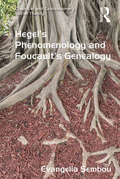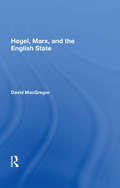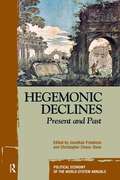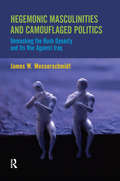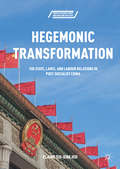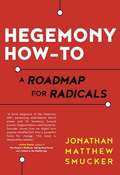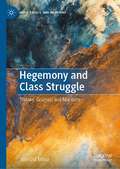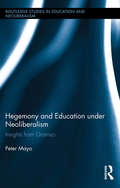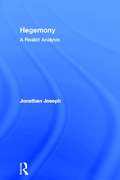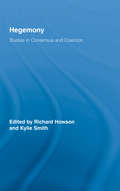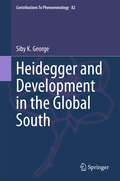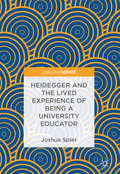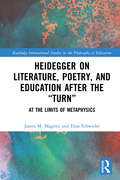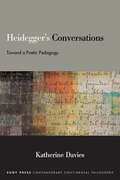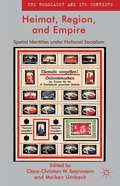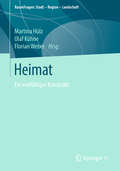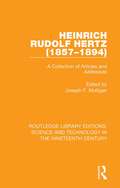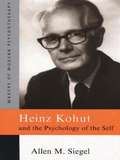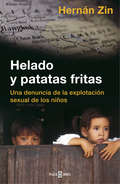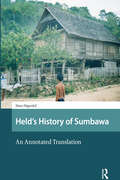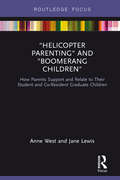- Table View
- List View
Hegel's Phenomenology and Foucault's Genealogy (Classical And Contemporary Social Theory Ser.)
by Evangelia SembouPreviously considered two different strands within continental thought, this book compares and contrasts Hegel's 'phenomenology' and Foucault's 'genealogy', contending that in spite of their differences, these approaches share important commonalities, most notably in the manner in which they dispense with distinctions between subject and object, theory and praxis, mind and body, and reason and nature, thus pointing the way to a form of social and political theorizing without presuppositions. Considering the possibility of developing a dialectical approach of 'phenomenology' and 'genealogy', this volume develops our understanding of critical theory, whilst engaging in debates concerning truth and knowledge in the philosophy of the social sciences. A rich exploration of the significance and implications of Hegel's 'phenomenology' and Foucault's 'genealogy' for the social sciences, it will be of interest to philosophers, as well as to social and political theorists.
Hegel, Marx, And The English State
by David MacGregorIn this radically revised intellectual portrait of Hegel and Marx that challenges standard interpretations of their political theory, David MacGregor considers the nature of the state in capitalist society. This is the first book to place Marx’s and Hegel’s political thought directly into social and historical context. Revealing the revolutionary c
Hegemonialer Kampf um die öffentliche Sphäre: Eine kultursoziologische Reflexion des Rechtspopulismus
by Marian PradellaDieses Buch widmet sich anhand des Fallbeispiels der „Alternative für Deutschland“ (AfD) den Auswirkungen rechtspopulistischer Diskurse auf eine öffentliche Sphäre. Der Blick richtet sich zunächst auf die Entwicklung der sozialwissenschaftlichen Populismuskonzeption, wobei an eine Unterscheidung „ideeller“ und „objektiver“ Ansätze angeschlossen wird. In Anschluss an Zygmunt Bauman, Chantal Mouffe, Ernesto Laclau sowie Jeffrey C. Alexander wird im Folgenden eine kultursoziologisch-poststrukturalistische Forschungsperspektive entworfen, die symbolische Dimensionen des Sozialen, kulturelle Ordnungen und Sinnstrukturen fokussiert. Hierauf aufbauend wird anhand einer diskurstheoretisch „verdichteten“ dichten Beschreibung die Entwicklung der (frühen) AfD offengelegt, wobei der Fokus auf Demonstrationsreden und anderen öffentlichen Veranstaltungen liegt. Schließlich werden die makrosoziologischen Bedingungen des Emporsteigens des Rechtspopulismus eruiert und letzterer wird im Spannungsfeld agonistischer und antagonistischer öffentlicher Sphären verortet.
Hegemonic Decline: Present and Past (Political Economy of the World-System Annuals)
by Christopher Chase-Dunn Jonathan FriedmanAlthough the United States is currently the world's only military and economic superpower, the nation's superpower status may not last. The possible futures of the global system and the role of U.S. power are illuminated by careful study of the past. This book addresses the problems of conceptualizing and assessing hegemonic rise and decline in comparative and historical perspective. Several chapters are devoted to the study of hegemony in premodern world-systems. And several chapters scrutinize the contemporary position and trajectory of the United States in the larger world-system in comparison with the rise and decline of earlier great powers, such as the Dutch and British empires. Contributors: Kasja Ekholm, Johnny Persson, Norihisa Yamashita, Giovanni Arrighi, Beverly Silver, Karen Barkey, Jonathan Friedman, Christopher Chase-Dunn, Rebecca Giem, Andrew Jorgenson, John Rogers, Shoon Lio, Thomas Reifer, Peter Taylor, Albert Bergesen, Omar Lizardo, Thomas D. Hall.
Hegemonic Masculinities and Camouflaged Politics: Unmasking the Bush Dynasty and Its War Against Iraq
by James W. MesserschmidtAnalyzing the speeches of the two Bush presidencies, this book presents a new conceptualization of hegemonic masculinity by making the case for a multiplicity of hegemonic masculinites locally, regionally, and globally. This book outlines how state leaders may appeal to particular hegemonic masculinites in their attempt to "sell" wars and thereby camouflage salient political practices in the process. Messerschmidt offers a fresh historical perspective on the war against Iraq over an 18-year period, and he argues that we cannot truly understand this war outside of its gendered (masculine) and historical context.
Hegemonic Transformation: The State, Laws, and Labour Relations in Post-Socialist China (Series in Asian Labor and Welfare Policies)
by Elaine Sio-ieng HuiThis book contends that the Chinese economic reform inaugurated since 1978 has been a top-down passive revolution, in Gramsci’s term, and that after three decades of reform the role of the Chinese state has been changing from steering the passive revolution through coercive tactics to establishing capitalist hegemony. It illustrates that the labour law system is a crucial vehicle through which the Chinese party-state seeks to secure the working class’s consent to the capitalist class’s ethno-political leadership. The labour law system has exercised a double hegemonic effect with regards to the capital-labour relations and state-labour relations through four major mechanisms. However, these effects have influenced the Chinese migrant workers in an uneven manner. The affirmative workers have granted active consent to the ruling class leadership; the indifferent, ambiguous and critical workers have only rendered passive consent while the radical workers has refused to give any consent at all.
Hegemony How-To: A Roadmap for Radicals
by Jonathan SmuckerA guide to political struggle for a generation that is deeply ambivalent about power. While many activists gravitate toward mere self-expression and identity-affirming rituals at the expense of serious political intervention, Smucker provides an apologia for leadership, organization, and collective power, a moral argument for its cultivation, and a discussion of dilemmas that movements must navigate in order to succeed.
Hegemony and Class Struggle: Trotsky, Gramsci and Marxism (Marx, Engels, and Marxisms)
by Juan Dal MasoLeon Trotsky and Antonio Gramsci are two of the most important Marxist thinkers of the 20th century. This book explores the similarities and the differences between their philosophical and political theories. The first and second chapters deal with a still under-investigated aspect of Trotsky’s thought, i.e. his reflections on the issue of hegemony. The third chapter focuses on Gramsci’s critique of Trotsky in his Prison Notebooks, analysing Gramsci’s knowledge of Trotsky’s positions as well as the scope and limits of Gramsci’s critique. The fourth chapter consists of a critical rereading of Perry Anderson's essay Antinomies of Antonio Gramsci, originally published in 1976 and republished in 2017 and an analysis of the book Gramsci and Trotsky in the Shadow of Stalinism by Emanuele Saccarelli. The result is an investigation that offers new insight into both Trotsky’s and Gramsci’s thought, while proposing a new point of view from which to interpret revolutionary theory and strategy in the contemporary scenario. One of the main topics addressed throughout the three essays is the specific position of the problem of hegemony in a theory of permanent revolution, demonstrating that Trotsky had a particular understanding of the question of hegemony and that Gramsci, in turn, introduced a concept of hegemony that is closely associated with an idea of permanent revolution, such that the dynamics of the relationship between democratic struggles and socialist struggles presented in both theories are very similar.
Hegemony and Education Under Neoliberalism: Insights from Gramsci (Routledge Studies in Education, Neoliberalism, and Marxism #8)
by Peter MayoBased in a holistic exposition and appraisal of Gramsci’s writings that are of relevance to education in neoliberal times, this book--rather than simply applying Gramsci's theories to issues in education--argues that education constitutes the leitmotif of his entire oeuvre and lies at the heart of his conceptualization of the ancient Greek term hegemony that was used by other political theorists before him. Starting from this understanding, the book goes on to compare Gramsci's theories with those of later thinkers in the development of a critical pedagogy that can confront neoliberalism in all its forms.
Hegemony: A Realist Analysis (Routledge Studies in Critical Realism)
by Jonathan JosephHegemony: A Realist Analysis is a new and original approach to this important concept. It presents a theoretical history of the use of hegemony in a range of work starting with a discussion of Gramsci and Russian Marxism and going on to look at more recent applications. It examines the current debates and discusses the new direction to Marx made by Jacques Derrida, before outlining a critical realist/Marxist alternative.This book employs critical realist philosophy in an explanatory way to help clarify the concept of hegemony and its relation to societal processes. This work contributes to recent debates in social science and political philosophy, developing both the concept of hegemony itself, and the work of critical realism.
Hegemony: Studies in Consensus and Coercion (Routledge Studies in Social and Political Thought #Vol. 56)
by Kylie Smith Richard HowsonThe originality and depth of Gramsci's theory of hegemony is now evidenced in the wide-ranging intellectual applications within a growing corpus of research and writings that include social, political and cultural theory, historical interpretation, gender and globalization. The reason that hegemony has been so widely and diversely adopted lies in the unique way that Gramsci formulated the 'problematics' of structure/superstructure, coercion/consensus, materialism/idealism and regression/progression within the concept hegemony. However, in much of the contemporary literature the full complexity of hegemony is either obfuscated or ignored. Hegemony, through comprehensive and systematic analyses of Gramsci's formulation, a picture of hegemony as a complex syncretism of these dichotomies. In other words, hegemony is presented as a concept that is as much about aspiration and progressive politico-social relations as it is about regressive and dominative processes. Thus, the volume recognises and presents this complexity through a selection of contemporary theoretical as well as historico-social investigations that mark a significantly innovative moment in the work on hegemony.
Heidegger and Development in the Global South
by Siby K. GeorgeTaking the Heideggerian critical ontology of technology as its base, this volume looks at postcolonial modernization and development in the global south as the worldwide expansion of the western metaphysical understanding of reality. We live today in an increasingly globalizing technological society that Martin Heidegger described in the middle of the last century as 'the planetary imperialism of technologically organized man. ' Consequent upon this cultural-intellectual globalization, the ahistorical, violent, individualistic, calculative and capitalistic logic of the metaphysics of technology is permeating the life-world, even of the world's poorest peoples, in ways they could neither choose nor control. This volume questions the political ethics and justice of post-war development discourse in the light of the egalitarian aims of modern societies, cultural freedom of communities and nations and the ecological limits of the planet. The final chapters discuss the alternative proposal of development as various conceptions of good life and equitable human flourishing amidst equally flourishing non-human life and non-living beings. This unique volume is the first book-length treatment of the ontology of modernization and development in the global south from a Heideggerian stance.
Heidegger and Executive Education: The Management of Time (New Directions in the Philosophy of Education)
by Toby ThompsonGlobal corporations and the senior executives who oversee them have been subject to great criticism in recent times: not only do such corporations hold extreme concentrations of wealth, but they continue to sanction staggering pay inequalities between the haves and the have-nots. At the same time, university-based business schools are conducting programmes of executive education seemingly customised to sanction these same inequalities. Heidegger and Executive Education is a piece of critical philosophy that has been written from within the business school in order to examine how this sheltered process of educating in-role corporate executives operates. Thompson claims that executive education is based on a very simple premise: that an executive executes an order, and that executive education is an amelioration of that process. Thompson argues that the easiest way to conceive of executive education is to treat order and execution as cognates, as a single conceptual entity. Thus, he asks, if educating executives in line with the order-execution cognate involves swapping the boardroom for the classroom, and in keeping with the ‘critical’ tag, shouldn’t executive education be about questioning not only the execution, but also the dominant order? The author uses ‘time’ as the philosophical method by which one can undo the order-execution cognate, question the sanctity of the cognate and thereby halt the seemingly inexorable temporal sequence from order through to those orders becoming executed. This book uses Martin Heidegger’s exotic philosophy of time in order to mount a philosophical challenge to the temporal sequentiality of executive education. It will therefore be of great interest to academics, researchers and postgraduates who are interested in Heidegger, the philosophy of education and executive education. It should also be essential reading for those involved in training, developing, and educating corporate executives.
Heidegger and the Lived Experience of Being a University Educator
by Joshua SpierThis book explores the lived meanings of being a university educator from an existential perspective. The book enriches our understanding of educators' experiences in light of Martin Heidegger's early philosophy, and vice versa (opening our understanding of Heidegger's philosophy through educators' experiences). Also drawing on the philosophical insights of Hans-Georg Gadamer, the book situates the purposes and experiences of the ‘educator’ in historical and contemporary contexts. In doing so, the author reveals that being a university educator is essentially characterised by conversation and time. Inspired by the author’s own experiences of teaching community development and sociology within a youth-work specific bachelor degree, the book invites educators to apply existential philosophy as a tool to reflect upon their own experiences and to reconnect with the question of what it means to be an educator in their shared world of practice. This thoughtful volume is sure to resonate with the experiences of readers who educate within a university context.
Heidegger in the Face of the Environmental Question: The Immanence of Life (Critiques and Alternatives to Capitalism)
by Enrique LeffThis volume engages with the work of Heidegger to argue that the modern environmental crisis is fundamentally a crisis of understanding Life, resulting from the symbolic codification of the world from the Logos of Greek philosophy to the rationality of the modern world and resulting in a metaphysics that privileges ontological thinking on the "question of being" over the environmental question and the concern for the conditions of life. Exploring the work of the three principal thinkers of the Lebensphilosophie— Bergson, Dilthey, and Husserl—it charts the itinerary of Heidegger’s work and exposes its conflicts with the work of Marx, Plessner, Haar, and Derrida. A critical argument against the colonization of the world by Eurocentric reason and for the deconstruction of Capital, Heidegger in the Face of the Environmental Question draws on Latin American environmental thought to re-think the conditions for life on Earth. It will therefore appeal to scholars of philosophy, political theory, and political sociology with interests in environmental philosophy, political ecology, and socioeconomic transformation.
Heidegger on Literature, Poetry, and Education after the “Turn”: At the Limits of Metaphysics (Routledge International Studies in the Philosophy of Education #45)
by James M. Magrini Elias SchwielerOffering new and original readings of literature, poetry, and education as interpreted through the conceptual lens of Heidegger’s later philosophy of the "Turn", this book helps readers understand Heidegger’s later thought and presents new takes on how to engage the themes that emerged from his later writing. Suggesting novel ways to consider Heidegger’s ideas on literature, poetry, and education, Magrini and Schwieler provide a deep understanding of the "Turn," a topic not often explored in contemporary Heideggerian scholarship. Their inter- and extra-disciplinary postmodern approaches offer a nuanced examination, taking into account Heidegger’s controversial place in history, and filling a gap in educational research.
Heidegger's Conversations: Toward a Poetic Pedagogy (SUNY series in Contemporary Continental Philosophy)
by Katherine DaviesReading Martin Heidegger's five conversational texts together for the first time, Heidegger's Conversations elaborates not only what Heidegger thought but how he did so by attending to the philosophical possibilities of the genre of these under-studied texts written between 1944 and 1954. Though he wrote little on the topic of teaching and learning explicitly, Katherine Davies shows Heidegger performed an implicit poetic pedagogy in his conversations that remains to be recognized. Heidegger launched an experimental attempt to enact a learning of non-representational, non-metaphysical thinking by cultivating a distinctly collaborative sensitivity to the call of the poetic. Davies illustrates how each conversation emphasizes a particular pedagogical element—non-oppositionality, making mistakes, thinking in community, poetic interpretation, and the dangers of such pedagogy—which together constitute the developmental arc of these texts. Whether Heidegger is revising or reinforcing his own earlier pedagogical practices, Davies argues that attending to the dramatic staging of the conversations offers a distinct vantage point from which to contend with Heidegger's philosophy and politics in the post-war period.
Heimat, Region, and Empire
by Claus-Christianw. Szejnmann Maiken UmbachThis collection brings together international scholars pursuing cutting-edge research on spatial identities under National Socialism. They demonstrate that the spatial identities of the Third Reich can be approached as a history of interrelated dimensions; Heimat, region and Empire were constantly reconstructed through this interrelationship.
Heimat: Ein vielfältiges Konstrukt (RaumFragen: Stadt – Region – Landschaft)
by Olaf Kühne Florian Weber Martina HülzDie politischen und gesellschaftlichen Diskussionen um Heimat intensivieren sich. Im Kontext des Versuchs der Selbstvergewisserung im Zuge der Globalisierung, aber auch der Differenzierung und Fragmentierung der Gesellschaft, der Einwanderung sowie landschaftlichen Wandlungsprozessen nehmen die Kämpfe um Deutungshoheit um das Heimatliche und das Nicht-Heimatliche an Schärfe zu. Mit dem Band ‚Heimat. Ein vielfältiges Konstrukt‘ soll ein Beitrag eigens aus raum-, politik- und medienwissenschaftlichen sowie soziologischen Perspektiven zur Klärung und Einordnung unterschiedlicher Positionen im Kontext des ‚umkämpften Feldes Heimat‘ geleistet werden.
Heinrich Heines „Romanzero“: Mythisches Denken und resignatives Geschichtsbild (Heine-Studien)
by Philipp RitzenDie Untersuchung des letzten großen Gedichtzyklus von Heinrich Heine, des „Romanzero“, legt mythische Denkstrukturen frei, die nach einschlägigen Mythostheorien (Blumenberg, Eliade) eine ordnende Funktion in einer dem Menschen als Chaos erscheinenden Welt erhalten. Zugleich ist mythisches Denken zyklisch. Heine gestaltet im „Romanzero“ historische Situationen aus allen Epochen und zeichnet drastisch die Perpetuierung von Herrschaft und Ungleichheit nach. Der Mythos vermag keine Hoffnung zu kreieren. Heine entwirft am Ende seines Lebens in seiner „Matratzengruft“ ein resignatives Bild von Menschheit und Geschichte.
Heinrich Rudolf Hertz: A Collection of Articles and Addresses (Routledge Library Editions: Science and Technology in the Nineteenth Century #6)
by Joseph F. MulliganThis book, first available in 1994, was published to commemorate the one-hundredth anniversary of Heinrich Hertz’s death at the terribly young age of thirty-six. The introductory biography together with eleven papers by Hertz and seven about him are intended to highlight the importance of Hertz’s contributions to physics and at the same time to serve the needs of anyone interested in doing research on this highly gifted scientist.
Heinz Kohut and the Psychology of the Self
by Allen M. SiegelA review of the pioneering work of psychoanalyst Kohut describing the theoretical development of his ideas and exploring their significance in various therapeutic situations outside of psychoanalysis. Siegal outlines Kohut's concepts of empathy, self-objects, transference, and his seminal work in narcissism, tying in his clinical observations and concerns with the meaning of a "curative psychology." The volume features an introductory psychological portrait of Kohut written by Ernest S. Wolf. Annotation c. by Book News, Inc., Portland, Or.
Helado y patatas fritas: Una denuncia de la explotación sexual de los niños
by Hernán ZinNo hay nada peor que abusar de un inocente, de un niño, que no sabe que ese hombre que le invita a helado y patatas fritas y le da unas monedas para que su familia coma, le está arruinando la vida. Hernán Zin, promotor de ayuda a la infancia a través de distintas ONG, descubrió varios casos de pederastia en Camboya y consiguió pruebas para llevar a algunos de esos hombres ante los tribunales. En Helado y patatas fritas se cuentan casos reales en los que se abre el corazón de los niños y los pederastas ofrecen su testimonio. Europeos que viajan a países del Tercer Mundo para llevar a cabo sus fantasías con niños de cuatro y cinco años: «Niños pobres que no entienden de moral, a los que yo ayudo con dinero», confiesa uno de ellos. Ahora Zin ha emprendido una campaña para luchar contra el abuso de niños en el Tercer Mundo, con recogidas de firmas y denuncias en el Parlamento Europeo e Interpol. También ha rodado un documental que podrá verse en varias cadenas de televisión nacionales y autonómicas, en el que se relata los mismos hechos. A raíz de esta investigación, la ONG Global Humanitaria ha puesto en marcha hogares para niños víctimas de abusos, además de un programa para seguir, denunciar y llevar a juicio en Camboya a quienes explotan sexualmente a menores. UN PORCENTAJE DE LAS VENTAS DE ESTE LIBRO SE DESTINARÁ A LUCHAR CONTRA LA PEDERASTIA EN EL TERCER MUNDO.
Held's History of Sumbawa: An Annotated Translation (Asian History)
by Hans HägerdalSumbawa is a medium-sized island in eastern Indonesia which has a particularly interesting past. In the premodern era it lay on the trade routes that connected the north coasts of the islands of Melaka and Java with the spice-producing areas in Maluku, while Sumbawa itself exported horses, sappan wood, and rice. Its recorded history covers periods of Hindu-Javanese influence, the Southeast Asian Age of Commerce, early Islamisation, and Dutch colonialism. Dutch Indologist Gerrit Jan Held wrote this book in 1955 but died before it could be published; this volume represents its first translation into English, and includes extensive footnotes that set it in context of current research.
Helicopter Parenting and Boomerang Children: How Parents Support and Relate to Their Student and Co-Resident Graduate Children (Routledge Advances in Sociology)
by Jane Lewis Anne WestDrawing an unfavourable contrast between the position of students and graduates with that of their baby boomer parents has become a staple for media comment. Indeed, student indebtedness and difficulties in finding graduate jobs and housing typically contrasts markedly with their parents’ experiences. Broadening the investigation, ‘Helicopter Parenting’ and ‘Boomerang Children’ depicts how students and graduates are now likely to be close to their parents, receive considerable financial and emotional support from them and, upon graduation, return home. Using qualitative data from two interview studies of middle-class families, this title explores the impact of these changes on young people’s transition to independence and adulthood and on intergenerational and intragenerational equality. This enlightening monograph will appeal to undergraduate and postgraduate students interested in fields such as Social Policy, Family Sociology and Education.
